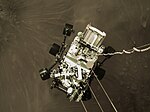2MASS J04070752+1546457
| Observation data Epoch J2000 Equinox J2000 | |
|---|---|
| Constellation | Taurus |
| Right ascension | 04h 07m 07.527s[1] |
| Declination | +15° 46′ 45.540″[1] |
| Characteristics | |
| Spectral type | L3.5[2] |
| Apparent magnitude (G) | 20.704 ± 0.014[1] |
| Apparent magnitude (J) | 15.478 ± 0.058[1] |
| Apparent magnitude (H) | 14.354 ± 0.057[1] |
| Apparent magnitude (K) | 13.559 ± 0.038[1] |
| Astrometry | |
| Radial velocity (Rv) | 43.4 ± 2.1[2] km/s |
| Proper motion (μ) | RA: 61.250 ± 3.490[1] mas/yr Dec.: –53.130 ± 2.712[1] mas/yr |
| Parallax (π) | 27.4408 ± 1.7735 mas[1] |
| Distance | 119 ± 8 ly (36 ± 2 pc) |
| Details[2] | |
| Mass | 0.064+0.009 −0.027 M☉ |
| Radius | 0.100+0.024 −0.008 R☉ |
| Surface gravity (log g) | 5.2 ± 0.4 cgs |
| Temperature | 1840 ± 210 K |
| Rotation | 1.23±0.01 h |
| Rotational velocity (v sin i) | 82.6 ± 0.2 km/s |
| Age | 0.8+11.2 −0.65 Gyr |
| Other designations | |
| Database references | |
| SIMBAD | data |
2MASS J04070752+1546457 (abbreviated to 2MASS J0407+1546) is a rapidly-rotating brown dwarf of spectral class L3.5, located in the constellation Taurus about 119 light-years from Earth. With a photometrically measured rotation period of 1.23 hours, it is one of the fastest-rotating known brown dwarfs announced by a team of astronomers led by Megan E. Tannock in March 2021. With a rotational velocity of over 80 km/s (50 mi/s), it is approaching the predicted rotational speed limit beyond which it would break apart due to centripetal forces. As a consequence of its rapid rotation, the brown dwarf is slightly flattened at its poles to a similar degree as Saturn, the most oblate planet in the Solar System.[3] Its rapid rotation may enable strong auroral radio emissions via particle interactions in its magnetic field, as observed in other known rapidly-rotating brown dwarfs.[2]
Discovery
[edit]2MASS J0407+1546 was first catalogued as a point source in June 2003 by the Two Micron All-Sky Survey (2MASS) organized by the University of Massachusetts Amherst and the Infrared Processing and Analysis Center under the California Institute of Technology.[4] It was discovered to be a brown dwarf of the spectral class L3.5 by I. Neill Reid and collaborators, based on near-infrared spectra obtained in October 2005 with the Gemini North at the Mauna Kea Observatory, Hawaii. Their discovery and spectroscopic characterization of 430 ultracool dwarfs including 2MASS J0407+1546 was published in The Astronomical Journal in September 2008.[5]
Distance
[edit]The trigonometric parallax of 2MASS 1114−2618 was measured to be 27.4408±1.7735 milliarcseconds by the Gaia spacecraft in 2018, corresponding to a distance of 36.4 ± 2.4 parsecs (118.7 ± 7.8 ly).[1] This is in close agreement with Reid et al.'s spectrophotometric estimate of 33.1 ± 3.3 parsecs (108 ± 11 ly) in 2008, calculated from the object's spectral type and near-infrared absolute magnitude.[5]
Proper motion
[edit]From Gaia DR2, 2MASS J0407+1546 has a measured net proper motion of 81.0 mas/yr with position angle 139.06 degrees,[a][b] indicating motion in south-east direction on the sky.[1]
See also
[edit]- 2MASS J12195156+3128497 – L8 spectral class brown dwarf with a period of 1.14+0.03
−0.01 h - 2MASS J03480772−6022270 – T7 spectral class brown dwarf with a period of 1.080+0.004
−0.005 h
Notes
[edit]References
[edit]- ^ a b c d e f g h i j k l "2MASS J04070752+1546457 -- Brown Dwarf (M<0.08solMass)". SIMBAD. Centre de données astronomiques de Strasbourg. Retrieved 4 March 2021.
- ^ a b c d Tannock, Megan E.; Metchev, Stanimir; Heinze, Aren; Miles-Páez, Paulo A.; Gagné, Jonathan; Burgasser, Adam; et al. (March 2021). "Weather on Other Worlds. V. The Three Most Rapidly Rotating Ultra-cool Dwarfs". The Astronomical Journal. 161 (5): 224. arXiv:2103.01990. Bibcode:2021AJ....161..224T. doi:10.3847/1538-3881/abeb67. S2CID 232105126.
- ^ Cofield, Calla (7 April 2021). "Trio of Fast-Spinning Brown Dwarfs May Reveal a Rotational Speed Limit". Jet Propulsion Laboratory. NASA. Retrieved 7 April 2021.
- ^ Cutri, Roc M.; Skrutskie, Michael F.; Van Dyk, Schuyler D.; Beichman, Charles A.; Carpenter, John M.; Chester, Thomas; Cambresy, Laurent; Evans, Tracey E.; Fowler, John W.; Gizis, John E.; Howard, Elizabeth V.; Huchra, John P.; Jarrett, Thomas H.; Kopan, Eugene L.; Kirkpatrick, J. Davy; Light, Robert M.; Marsh, Kenneth A.; McCallon, Howard L.; Schneider, Stephen E.; Stiening, Rae; Sykes, Matthew J.; Weinberg, Martin D.; Wheaton, William A.; Wheelock, Sherry L.; Zacarias, N. (2003). "VizieR Online Data Catalog: 2MASS All-Sky Catalog of Point Sources (Cutri+ 2003)". CDS/ADC Collection of Electronic Catalogues. 2246: II/246. Bibcode:2003yCat.2246....0C.
- ^ a b Reid, I. Neill; Cruz, Kelle L.; Kirkpatrick, J. Davy; Allen, Peter R.; Mungall, F.; Liebert, James; Lowrance, Patrick; Sweet, Anne (September 2008). "Meeting the Cool Neighbors. X. Ultracool Dwarfs from the 2MASS All-Sky Data Release". The Astronomical Journal. 136 (3): 1290–1311. arXiv:0806.3413. Bibcode:2008AJ....136.1290R. doi:10.1088/0004-6256/136/3/1290. S2CID 123222597.
External links
[edit]- Trio of Fast-Spinning Brown Dwarfs May Reveal a Rotational Speed Limit, Calla Cofield, Jet Propulsion Laboratory, 7 April 2021
- Western space scientists identify fastest-spinning "failed stars" ever found, Jeff Renaud, University of Western Ontario, 7 April 2021
- Caught Speeding: Clocking the Fastest-Spinning Brown Dwarfs, NOIRLab, 7 April 2021







